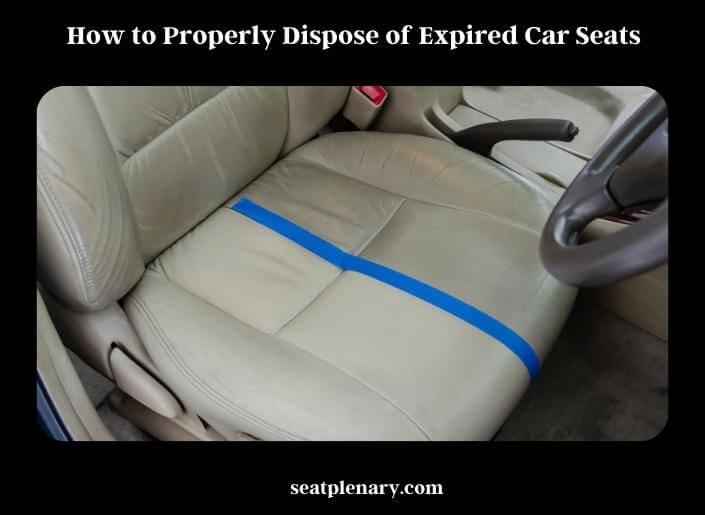Car safety is a top priority for parents, and a vital aspect of car safety is ensuring that children are properly secured in car seats. Car seats protect children from injuries and potential death during a car accident, making them an essential safety feature for families.

Many parents may not be aware of an important factor that affects the safety of car seats – expiration dates. Like many other products, car seats have expiration dates, and it is crucial to follow them to ensure that the seat is functioning properly and offering maximum protection to the child.
Why Do Car Seats Expire?
Car seats are designed to provide maximum safety and protection for children during car rides. They are made of materials that are specifically chosen to withstand the forces of a crash and keep the child secure.
Over time, the materials in the car seat may deteriorate due to exposure to environmental factors such as heat, cold, moisture, and sunlight. Safety standards and regulations are constantly evolving, and new research and developments in car seat safety may make older models less effective at protecting children.
To address these issues, car seat manufacturers have established expiration dates for their products. These dates are typically around six years from the date of manufacture, although some car seats may have shorter or longer expiration dates depending on the specific make and model.
By establishing an expiration date, manufacturers ensure that their car seats are up-to-date with the latest safety standards and that they have not degraded to the point where they may fail to provide adequate protection during a crash.
It is important to note that car seat expiration dates are not arbitrary or optional. They are based on rigorous testing and research to determine the safe lifespan of the seat. Using an expired car seat can compromise the safety of the child and may result in serious injuries or death in the event of a car accident.
It is crucial to always follow the expiration dates provided by the manufacturer and replace the car seat when it has reached its expiration date.
How Long Do Car Seats Last?
Car seats are an essential safety feature that parents rely on to keep their children secure while on the road. Many parents may not be aware of the fact that car seats have an expiration date, and that they should replace them when they reach that date. But how long do car seats last, and how can you tell when they have expired?

Most car seat manufacturers recommend replacing car seats after around six years from the date of manufacture. This timeline can vary depending on the make and model of the car seat. Some manufacturers may suggest a shorter or longer lifespan, and it’s important to always follow the specific guidelines provided by the manufacturer.
Some factors can affect the lifespan of a car seat. For example, if the car seat has been involved in a crash, it should be replaced even if it appears undamaged, as the structure and integrity of the seat may have been compromised.
Exposure to environmental factors such as heat, cold, moisture, and sunlight can also affect the lifespan of the car seat, as these factors can cause materials to degrade and weaken over time.
To determine the expiration date of your car seat, you can look for the information on the label attached to the seat. This label should provide the date of manufacture, as well as the recommended expiration date for the specific make and model of the seat. If you are unsure about the expiration date of your car seat, you can contact the manufacturer or a certified car seat technician for guidance.
It’s important to note that even if a car seat appears to be in good condition and functioning properly, it should still be replaced when it reaches its expiration date. Following the recommended lifespan of the car seat can help ensure that your child remains safe and protected while riding in the car.
Risks of Using an Expired Car Seat
Using an expired car seat can compromise the safety of the child and may result in serious injuries or even death in the event of a car accident. As car seat age, they can become less effective at protecting children, as the materials used in the seat may deteriorate and lose their ability to withstand the forces of a crash. Safety standards and regulations are constantly evolving, and new research and developments in car seat safety may make older models less effective at protecting children.
Expired car seats may have weakened harnesses or straps, making them less secure and more likely to come loose during a crash. The seat may also be less effective at protecting the child’s head and neck in the event of a crash. The integrity of the seat’s structure may have been compromised, making it less effective at absorbing and distributing the force of a crash. All of these factors can increase the risk of injury or death to the child in the event of an accident.
Using an expired car seat can also have legal implications. If a child is injured while riding in an expired car seat, the parent or caregiver may be held liable for any damages or injuries resulting from the accident. This can result in costly lawsuits, fines, and other legal consequences.
To ensure the safety of children while riding in the car, it is crucial to always follow the expiration dates provided by the manufacturer and replace the car seat when it has reached its expiration date. It is important to properly dispose of expired car seats to prevent them from being used by others who may not be aware of the expiration date or the risks associated with using an expired car seat.
How to Properly Dispose of Expired Car Seats?
Properly disposing of an expired car seat is important to prevent it from being used by others who may not be aware of the expiration date or the risks associated with using an expired car seat. Here are some steps to follow when disposing of an expired car seat:

Check With Your Local Waste Management Facility
Many waste management facilities have specific guidelines for disposing of car seats. Contact your local facility to determine what their policies are and how to properly dispose of your car seat.
Remove All Straps and Padding
Before disposing of the car seat, remove all straps and padding to prevent them from being used in another car seat.
Cut the Straps and Cover
Cut the straps and cover (if your car seat covers can be dried in the dryer, check the care label or manufacturer’s instructions for specific guidelines) of the car seat to prevent someone from using them.
Label the car seat as expired: Write “expired” on the car seat in a permanent marker to alert anyone who may come into contact with it.
Disassemble the Car Seat
Disassemble the car seat as much as possible to make it less appealing to potential scavengers.
Recycle the Car Seat If Possible
Some car seats can be recycled, and many communities offer car seat recycling programs. Check with your local waste management facility or recycling center to see if they accept car seats for recycling.
Dispose of the Car Seat Properly
If you cannot recycle the car seat, dispose of it in the trash. Make sure to follow the guidelines provided by your local waste management facility for disposing of large items.
Tips for Choosing a Car Seat with a Longer Lifespan
When it comes to choosing a car seat with a longer lifespan, there are a few key factors to consider. Here are some tips to help you choose a car seat that will last longer:
Look for a car seat with a higher weight and height limit: Car seats with higher weight and height limits can be used for longer periods of time, as they can accommodate growing children.
Choose a convertible car seat: Convertible car seats can be used in both rear-facing and forward-facing positions and can accommodate children up to 65 or 80 pounds depending on the model. This can extend the life of the car seat and reduce the need for frequent replacements.
Consider the quality of the materials: High-quality materials can help a car seat last longer and maintain its effectiveness. Look for car seats made from durable materials that can withstand the wear and tear of regular use.
Check the expiration date: Make sure to check the expiration date of the car seat before purchasing it, and choose a car seat with a longer expiration date.
Follow the manufacturer’s guidelines for use and maintenance: Following the manufacturer’s guidelines for use and maintenance can help extend the life of the car seat. Make sure to properly install the car seat, clean it regularly, and follow any other maintenance recommendations provided by the manufacturer.
Invest in a reputable brand: Choosing a car seat from a reputable brand with a proven track record of safety and quality can help ensure that the car seat will last longer and provide effective protection for your child.
Tips for Car Seat Safety
Car seat safety is crucial to protect children from injuries in case of a car accident. Here are some tips to ensure that your child’s car seat is properly installed and used:
Use the Right Car Seat
Make sure you choose a car seat that is appropriate for your child’s age, weight, and height. The American Academy of Pediatrics recommends that infants and toddlers be placed in a rear-facing car seat until they are at least 2 years old or until they reach the highest weight or height allowed by the car seat manufacturer.
Install the Sar Seat Correctly
Follow the manufacturer’s instructions carefully to ensure that the car seat is installed properly. Make sure that the car seat is securely and tightly fastened to the vehicle’s seat.
Use the Harness Correctly
Make sure that the harness straps are snug and properly adjusted. The harness straps should be at or below your child’s shoulders for rear-facing seats, and at or above the shoulders for forward-facing seats. The chest clip should be placed at the armpit level.
Position the Car Seat Correctly
For rear-facing seats, the car seat should be reclined at the correct angle to keep your child’s head from flopping forward. For forward-facing seats, the car seat should be in an upright position.
Keep Your Child in the Car Seat for as Long as Possible
Don’t rush to move your child to the next type of car seat. Children should remain in a rear-facing car seat until they are at least 2 years old or until they reach the highest weight or height allowed by the car seat manufacturer.
After that, they should be placed in a forward-facing car seat with a harness until they are at least 4 years old or until they reach the highest weight or height allowed by the car seat manufacturer.
Children should be placed in a booster seat until they are big enough to use a seat belt without it riding up on their abdomen (usually when they are about 4’9″ tall).
Register Your Car Seat
Fill out the registration card that comes with your car seat so that you can be notified of any safety recalls.
Set a Good Example
Always wear your seat belt and make sure that all passengers in your car do the same. This sets a good example for your child and reinforces the importance of car seat safety.
Conclusion
Car seat expiration dates are an important consideration for parents and caregivers when it comes to the safety of children in vehicles. Using an expired car seat can increase the risk of injury in the event of a car accident, as the car seat may no longer provide adequate protection.
It’s important to be aware of the expiration date of your child’s car seat and to replace it when it reaches its expiration date. When disposing of an expired car seat, make sure to do so properly by following the guidelines provided by your local waste management facility.
When choosing a car seat, consider factors such as weight and height limits, materials, expiration date, and manufacturer guidelines for use and maintenance. By selecting a car seat with a longer lifespan and following proper care and maintenance guidelines, you can help ensure the safety of your child while traveling in a vehicle.
